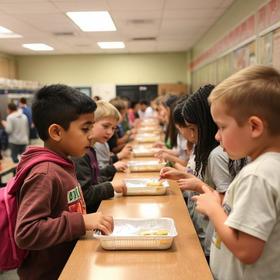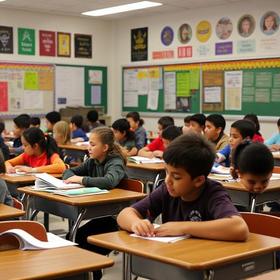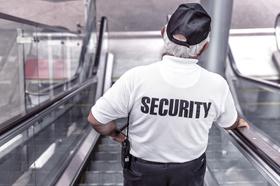Merlo Station Night School serves 48 students in grades 10-12.
The percentage of students achieving proficiency in math was ≥50% (which was lower than the Oregon state average of 64%). The percentage of students achieving proficiency in reading/language arts was ≥50% (which was lower than the Oregon state average of 74%).
The student-teacher ratio of 24:1 was higher than the Oregon state level of 17:1.
Minority enrollment was 61% of the student body (majority Hispanic), which was higher than the Oregon state average of 42% (majority Hispanic).
<麻豆果冻传媒 class='so-dt-title' id="overview">School Overview <麻豆果冻传媒 class='so-dt-title' id="school-rankings">School Rankings
School Type
Grades Offered
Grades 10-12
Total Students
48 students
Total Classroom Teachers
2 teachers
Math Test Scores (% Proficient)
(11-12)≥50%
64%
Reading/Language Arts Test Scores (% Proficient)
(11-12)≥50%
74%
Student-Teacher Ratio
24:1
17:1
American Indian
6%
1%
Asian
3%
4%
Hispanic
36%
26%
Black
9%
3%
White
39%
58%
Hawaiian
n/a
1%
Two or more races
7%
7%
All Ethnic Groups
Graduation Rate
(11-12)21-39%
71%
Eligible for Free Lunch
58%
51%
Eligible for Reduced Lunch
10%
3%
School Statewide Testing
School District Name
Source: National Center for Education Statistics (NCES), OR Dept. of Education
<麻豆果冻传媒 class='so-dt-title' id='faq'>Frequently Asked Questions What percent of students have achieved state testing proficiency in math and reading?
≥50% of students have achieved math proficiency (compared to the 64% OR state average), while ≥50% of students have achieved reading proficiency (compared to the 74% OR state average).
What is the graduation rate of Merlo Station Night School?
The graduation rate of Merlo Station Night School is 21-39%, which is lower than the Oregon state average of 71%.
How many students attend Merlo Station Night School?
48 students attend Merlo Station Night School.
What is the racial composition of the student body?
39% of Merlo Station Night School students are White, 36% of students are Hispanic, 9% of students are Black, 7% of students are Two or more races, 6% of students are American Indian, and 3% of students are Asian.
What is the student-teacher ratio of Merlo Station Night School?
Merlo Station Night School has a student ration of 24:1, which is higher than the Oregon state average of 17:1.
What grades does Merlo Station Night School offer ?
Merlo Station Night School offers enrollment in grades 10-12
What school district is Merlo Station Night School part of?
Merlo Station Night School is part of Beaverton School District 48j.
麻豆果冻传媒 Articles

How Public Schools Support Students on Free / Reduced-Lunch Programs
Explore how U.S. public schools support students eligible for free or reduced-price lunch through nutrition, academic, and wraparound services in 2025.

Hidden Costs of Public Schools: Fees, Supplies & Extras
Explore the hidden costs in public schools鈥攆ees, supplies, extracurriculars鈥攁nd how parents can plan for them in 2025.

Public School Funding 2025: What Families Should Know
Essential insights on public school funding in 2025鈥攈ow it works, what鈥檚 changing, and what families should know to stay ahead.




